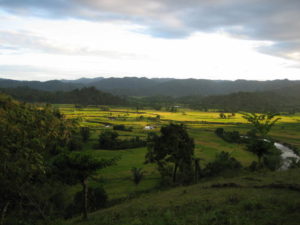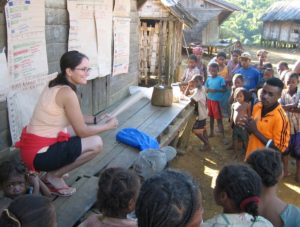
Environmental Anthropologist Georgina Cullman researches and advocates for conservation solutions that help both people and the environment.
Why do you think we should protect nature?

How do the people of Madagascar use the land in what is now a conservation area? Can they grow food on that land and make a living without destroying the rainforest? These are the kinds of questions Ecologist and Evolutionary Biologist Georgina Cullman, an environmental anthropologist now working at the American Museum of Natural History, asks.
Cullman’s grandmother first taught her about conservation. Together, they explored the Connecticut woods, where Georgina became interested in animals and the natural world. In high school, she participated in the Mountain School program, living on a farm and becoming familiar with the Vermont woods. This was “my first entree into how you might be able to do something in the environment. One person without knowledge might just see a forest, but with knowledge about which species of tree grow and their ages” Cullman began to see “mysteries you could decode” in the woods. Learning that the local sugar bushes were planted long ago, to produce maple syrup, was “an eye-opening experience.”
In college, Cullman continued studying the environment and in graduate school, she became uncomfortable with some of the ways conservation conflicted with the needs of human communities. She “wanted to see local people’s rights respected and their lives enhanced.” Her great-uncle, who hired former poachers to guard park land in Tanzania, demonstrated that conservation organizations can protect the natural environment in ways that help (and don’t harm) the people living there.

While working on her dissertation, Cullman traveled to Madagascar. “It’s a place where [some conservationists] blamed poor people for habitat destruction” and denied them access to their land. “This wasn’t working: deforestation was still happening. A park that excludes people doesn’t work,” explains Cullman.
In an area of northeastern Madagascar surrounding a protected rainforest, farmers grow food on banana, clove, and coffee plantations as well as in rice fields. In the understory (under the trees), they grow vanilla vines and pineapples. Where there once were rice fields, nature has restored the soil’s fertility, creating these agroforests.
“I used a lot of math in Madagascar,” says Cullman, explaining how she sampled each farmer’s land, gathering data about which species of trees grow there. Using two dice (“Local people thought I was gambling”), she would shake a number between two and 12, to randomize the beginning of the sample plot.
If I got seven, I would take a meter tape and hold it at the edge of the person’s land. And my research assistant would walk in 10 meters or so, to create a buffer from the edge. He would walk in 17 meters [in all] and that would be the edge of the plot that we would sample. We would mark it with some flagging tape. Then we would go in 50 meters (our plots were 50 meters in diameter) and we would do a cross to know where the edges of the circle were. Then we would walk around the edges of the plot and spiral in to make sure we had sampled every single tree in the plot.
The landowner helped Cullman and her assistant identify each tree species.

Using similar techniques, Cullman and her colleagues measured the understory, gathering data about the percent of the ground that was covered by plants. Using a 0.1-square-meter frame made out of PVC tubes with decimeters marked on them, the scientists estimated how much of that rectangle was covered by different objects. Which ground had plants growing on it? Which areas were bare, perhaps covered by rocks or fallen tree limbs? Cullman estimated the percent of ground covered by ferns, baby trees, vines, and other organic and inorganic objects, grouping them into herbs, grasses, woody plants, and leaf litter (dead leaves).
She explains that she “wanted to characterize the different land uses in order to understand the different ways” people value their land. What benefits do the people of that area of Madagascar, on the outskirts of a protected rainforest, get from the natural environment?
In New York City, we get clean water from Catskill reservoirs and don’t need a [water filtration] plant to filter our water (that’s because the forest does that for us). That’s a huge ecosystem service and New York City is very famous for having bought a bunch of land in the Catskills and forced that area to maintain forest cover, in order to avoid paying for a plant.

Forests provide many “ecosystem services.” They sequester carbon, staving off climate change. And they provide hydrological services: “If it rains really hard in a forest, the water won’t flow off fast. (That happens in areas with deforestation.) And “forests create rain just by being there.” They also provide people with construction materials for building homes, medicinal plants, and food. “You can quantify this for all of the different land uses” and compare the benefits and costs of farming versus other ecological benefits.
Combining different uses helps meet the different goals of Madagascar’s conservation project. These goals include increasing the forest cover, reducing “slash and burn” agriculture, and regenerating the forest. They aim to: support sustainable livelihoods, helping people earn a living; maintain biodiversity; and sequester carbon, preventing it from being released into the atmosphere, where it would contribute to global warming. Cullman’s work helps conservationists understand that they should include the agroforest in their plans, encouraging local farmers to benefit from growing food in the rainforest. “Conservation organizations working [in Madagascar] will have more success if they highlight the beneficial work of community members with agroforest land.”
At the American Museum of Natural History, in New York City, Cullman continues to make connections between people and their environment. In her words, “nurturing that link can be key to making sure the world’s cultural and biological diversity continues into the future.”


